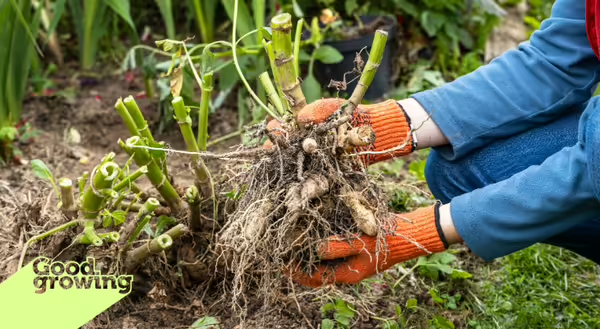
Plants like caladiums, cannas, dahlias, elephant ears, and gladiolus bring vibrant color and tropical flair to summer gardens. Unfortunately, they’re no match for our Midwestern winters. These plants, commonly referred to as tender or summer-blooming bulbs, will be killed by our cold winter temperatures if left outdoors. Therefore, if we don't want to buy new plants every year, we’ll need to dig and store them indoors for the winter.
Digging and cleaning up tender bulbs
Timing is important when it comes to digging tender bulbs. If they are dug too early, it reduces the amount of energy the plants can produce and store for next year. Wait too long and there is a risk the bulbs will be damaged by cold/frozen soil.
Once the foliage of the plants has begun to turn yellow or has been killed by a frost, it can be cut back. The plants should be dug up within a few days of a frost to prevent rot-causing organisms from entering the bulbs. Be careful when digging plants; if the bulbs are accidentally cut or 'skinned,' this creates an entry for pathogens that can quickly spread disease.
One way to avoid damaging the bulbs is to begin digging several inches away from the plant with a shovel or digging fork. Loosen the soil all around the plant, then lift the entire clump. After the clump has been lifted, remove any excess soil on the bulbs and discard any damaged bulbs. It's also a good idea to label the bulbs so that you know what's what come spring (there's nothing more frustrating than having a bunch of bulbs and having no idea what's what).
Curing and storing tender bulbs
Most bulbs will need a curing, or drying, period before being stored for the winter. This can be as short as 1 to 3 days (dahlias and cannas) to as long as three weeks for plants like gladiolus and callas. While drying, keep the bulbs out of direct sunlight and in a well-ventilated area with temperatures around 60 to 70°F.
Before storing bulbs, inspect them again for any signs of disease or insects. Discard or treat any bulbs that may have pest problems. If you store them with 'healthy' bulbs, the problems can spread over the winter and become a much larger problem.
While tender bulbs can be divided at this time, it is best to do this in the spring. Dividing plants will create wounds/openings in the plant, which can increase the likelihood of rot developing. When dividing, make sure each ‘new’ plant has at least one or two buds.
Dried bulbs can be stored in 2 to 3-inch layers of peat moss, sand, vermiculite, sawdust, or coconut coir in a well-ventilated container such as milk or bread crates or cardboard boxes. Try not to let bulbs touch one another while they are being stored. This will help prevent the spread of rot between bulbs.
For the most part, bulbs should be stored in a cool area with temperatures around 40 to 50°F, such as an unheated garage or unfinished basement.
Periodically check your bulbs throughout the winter and remove any that appear to be rotting. Also, check the moisture levels. If bulbs are beginning to shrink and become wrinkled, moisten the media they are being stored in with a spray bottle. Just make sure not to over-moisten them, as that can lead to rot.
Come spring, inspect bulbs for rot or shriveling. Replant outdoors after the last frost, or start indoors for earlier blooms.
Good Growing Fact of the Week: Despite the name, not all of them actually grow from bulbs. Other storage structures include corms (gladiolus), rhizomes (calla lilies), tubers (tuberous begonias), and tuberous roots (dahlias).
| Plant | Curing time | Storage |
|---|---|---|
| Caladium | 1-2 weeks | Around 60°F |
| Calla lily | 2-3 weeks | Around 50°F |
| Canna | 1-2 days | Around 45°F |
| Dahlia | 1-2 days | Aound 45°F |
| Elephant ear | 1-2 weeks | Around 55°F |
| Gladiolus | 2-3 weeks | Around 40°F |
Want to get notified when new Good Growing posts are available? SIGN ME UP!
Give us feedback! How helpful was this information (click one): Very helpful | Somewhat helpful | Not very helpful
MEET THE AUTHOR
Ken Johnson is a Horticulture Educator with University of Illinois Extension, serving Calhoun, Cass, Greene, Morgan, and Scott counties since 2013. Ken provides horticulture programming with an emphasis on fruit and vegetable production, pest management, and beneficial insects. Through his programming, he aims to increase backyard food production and foster a greater appreciation of insects.